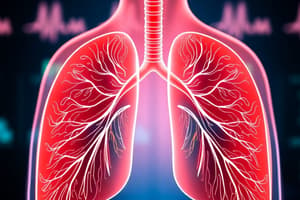Podcast
Questions and Answers
What is the function of total lung capacity?
What is the function of total lung capacity?
- To exchange 70 square meters of gas between the lungs and bloodstream
- To hold the amount of air in the lungs after a normal expiration
- To facilitate the exchange of oxygen and carbon dioxide
- To expel the maximum amount of air after a deep breath (correct)
What is the lungs' primary function in the respiratory system?
What is the lungs' primary function in the respiratory system?
- To produce oxygen for the bloodstream
- To cool down the air we breathe
- To filter out dust particles from the air (correct)
- To maximize the exchange of oxygen and carbon dioxide
What is the approximate vital capacity for an average adult female?
What is the approximate vital capacity for an average adult female?
- 6 liters
- 4 liters (correct)
- 2.5 liters
- 3 liters
How does functional residual capacity differ from vital capacity?
How does functional residual capacity differ from vital capacity?
Why is the surface area of the lungs important for gas exchange?
Why is the surface area of the lungs important for gas exchange?
If an adult male has a total lung capacity of 6 liters, what would be his functional residual capacity approximately?
If an adult male has a total lung capacity of 6 liters, what would be his functional residual capacity approximately?
What is the function of the diaphragm in the respiratory system?
What is the function of the diaphragm in the respiratory system?
Which respiratory disorder is characterized by recurring episodes of wheezing, shortness of breath, and coughing?
Which respiratory disorder is characterized by recurring episodes of wheezing, shortness of breath, and coughing?
What is the main symptom of pneumonia?
What is the main symptom of pneumonia?
Which group of muscles helps expand the ribcage during inhalation?
Which group of muscles helps expand the ribcage during inhalation?
What is a key mechanism used by the respiratory system to keep the airways clean?
What is a key mechanism used by the respiratory system to keep the airways clean?
Which respiratory disorder results in chronic lung infections and difficulty breathing due to thick mucus production in the airways?
Which respiratory disorder results in chronic lung infections and difficulty breathing due to thick mucus production in the airways?
Flashcards are hidden until you start studying
Study Notes
The Human Respiratory System: Lung Capacity, Disorders, and Breathing Mechanisms
The respiratory system is a complex network of organs and structures responsible for the life-sustaining process of gaseous exchange between our bodies and the environment. We breathe in air, extract oxygen, and expel carbon dioxide, all made possible by our lungs and the remarkable machinery of the respiratory system.
Lung Capacity
The lungs, comprising spongy, air-filled sacs called alveoli, occupy most of the thoracic cavity. Their primary function is to facilitate the exchange of oxygen and carbon dioxide between the air we breathe and the bloodstream. The lungs have a total surface area of about 70 square meters, which is roughly the size of a tennis court. This vast area allows for a large gas exchange capacity.
The lungs have three main capacities:
- Total lung capacity (TLC): The maximum amount of air a person can inhale and exhale at full lung expansion. It is approximately 6 liters for an average adult male and 5 liters for an average adult female.
- Vital capacity (VC): The maximum amount of air a person can expel after taking the deepest breath possible. Vital capacity is smaller than total lung capacity, about 4 liters in males and 3 liters in females.
- Functional residual capacity (FRC): The amount of air remaining in the lungs after a normal, quiet expiration. In an adult, functional residual capacity is approximately 2.5 liters for males and 2 liters for females.
Respiratory Disorders
The respiratory system is susceptible to various disorders, some of which are common, while others are rare. Some of the most prevalent conditions include:
- Asthma: A chronic inflammatory disease of the airways that causes recurring episodes of wheezing, shortness of breath, and coughing.
- Chronic obstructive pulmonary disease (COPD): A progressive disease that causes airflow obstruction and worsens over time, leading to symptoms such as chronic cough, wheezing, and shortness of breath.
- Pneumonia: An infection that inflames the air sacs in the lungs, causing coughing, difficulty breathing, and sometimes fever.
- Cystic fibrosis: A genetic disorder that causes the airways to produce thick, sticky mucus, leading to chronic lung infections and difficulty breathing.
Breathing Mechanisms
The respiratory system relies on several mechanisms to facilitate proper breathing:
- Diaphragm: A dome-shaped muscle that separates the thoracic cavity from the abdominal cavity. When the diaphragm contracts, it moves downwards and increases the volume of the thoracic cavity, allowing air to flow into the lungs.
- Intercostal muscles: A group of muscles between the ribs that help expand the ribcage during inhalation.
- Inspiration and expiration: The muscles involved in the respiratory process contract and relax to bring air in and out of the lungs.
- Airway defenses: The respiratory system has mechanisms such as mucociliary escalators and coughing to keep the airways clean and clear of debris and infection.
Understanding the human respiratory system is crucial for maintaining good health and preventing respiratory disorders. By exercising regularly, practicing good hygiene, and avoiding exposure to pollutants, we can protect and strengthen our lungs, ensuring the vital exchange of oxygen and carbon dioxide takes place seamlessly. Thomas, C. Physiology Explained: Understanding the Human Respiratory System - YouTube, January 22, 2021, https://www.youtube.com/watch?v=UyO6-Dd3Z_Q Lung Capacity - Healthline, https://www.healthline.com/health/lung-capacity Respiratory Disorders - National Heart, Lung, and Blood Institute, https://www.nhlbi.nih.gov/health-topics/respiratory-disorders#:~:text=Respiratory%20disorders%20affect%20the%20airways,air%20sacs%20in%20the%20lungs. How the Respiratory System Works - Anatomy & Physiology, https://www.medicalnewstoday.com/articles/324902#what-is-the-human-respiratory-system
Studying That Suits You
Use AI to generate personalized quizzes and flashcards to suit your learning preferences.




